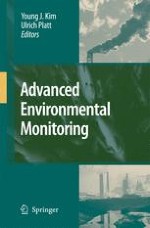
2008 | OriginalPaper | Buchkapitel
Air Pollution Monitoring Systems—Past–Present–Future
verfasst von : Director Ulrich Platt
Erschienen in: Advanced Environmental Monitoring
Verlag: Springer Netherlands
Aktivieren Sie unsere intelligente Suche, um passende Fachinhalte oder Patente zu finden.
Wählen Sie Textabschnitte aus um mit Künstlicher Intelligenz passenden Patente zu finden. powered by
Markieren Sie Textabschnitte, um KI-gestützt weitere passende Inhalte zu finden. powered by
Measurements of trace gas concentrations and other parameters like photolysis frequencies are a crucial tool for air pollution monitoring and the investigation of processes in the atmosphere. However, the determination of atmospheric trace gas concentrations constitutes a technological challenge, since extreme sensitivity (mixing ratios as low as 10
-13
) is desired simultaneously with high specifi city i.e. the molecule of interest usually must be detected in the presence of a large excess of other species. In addition, spatially resolved measurements are becoming increasingly important.
Today none of the existing measurement techniques meets all above requirements for trace gas measurements in the atmosphere. Therefore, a comprehensive arsenal of different techniques has been developed. Besides a large number of special techniques (like the ubiquitous short-path UV absorption for O
3
measurement) universal methods gain interest, due to their economy and relative ease of use. In particular, a single instrument can register a large number of different trace species.
The different types of requirements and the various techniques are discussed; special emphasis is given to spectroscopic methods, which play a large and growing role in atmospheric chemistry research. For instance, only spectroscopic methods allow remote sensing and spatially resolved determination of trace gas concentrations e.g. from space-borne platforms. Today many varieties of spectroscopic methods are in use (e.g. tunable diode laser- and Fourier-transform spectroscopy). The basic properties and recent applications of this technique are presented using differential optical absorption spectroscopy (DOAS) as an example. Future requirements and expected developments are discussed.
Keywords
: Air pollution monitoring, trace gas, DOAS, spectroscopy, remote sensing